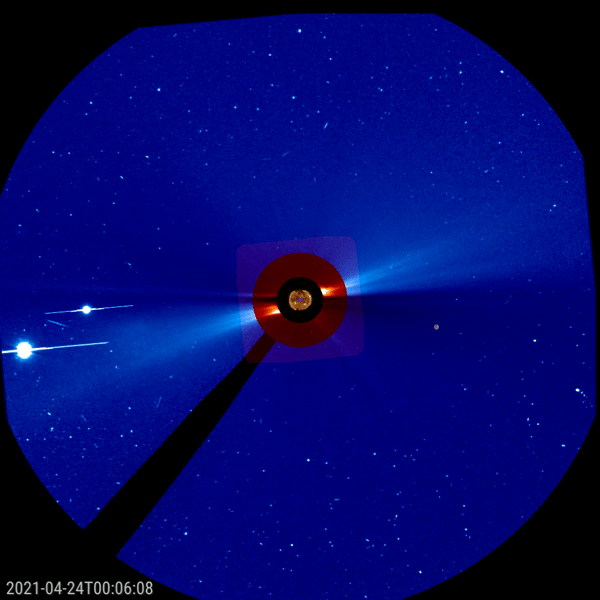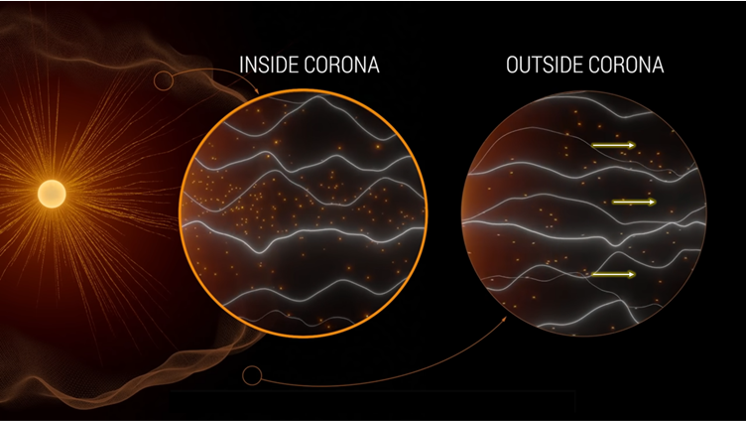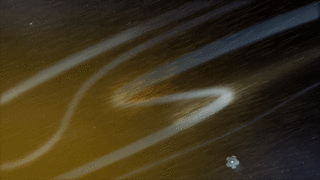The Parker Solar Probe reached new milestones in 2021, being the first spacecraft to fly through the Sun's corona, and tracing the magnetic switchbacks to their source. Over the next years, PSP will make even closer flybys of our star.The article underneath was inspired on the NASA's feature story, with a movie available at YouTube (NASA/GSFC).
For the first time in history, a spacecraft has flown through the Sun's upper atmosphere -the corona- and sampled particles and magnetic fields there. This major milestone from NASA's Parker Solar Probe (PSP) was announced during the 2021 American Geophysical Union Fall Meeting in New Orleans. The importance of this major step cannot be underestimated, as the corona holds many mysteries such as why it is so hot, or how the solar wind gets accelerated and as such impacts the entire solar system.
PSP was launched on 12 August 2018 from Cape Canaveral, Florida. Its main science goals are to trace the source(s) responsible for heating the corona to its multi-million degrees temperature, to find the acceleration mechanism for the solar wind, and to uncover the physical processes responsible for the accelaration and transport of the solar energetic particles. Through a series of well-calculated flybys of the planet Venus, PSP's orbit is getting altered such that the perihelions (i.e. the closest distance to the Sun during PSP's orbit around our star) are gradually lowered: from 24.8 million km during its first perihelion late 2018 to 11.1 million km in April 2021, and eventually to 6.9 million km from late 2024 onwards, which is less than 10 solar radii! Underneath animation shows the April 2021 perihelion as calculated by STCE scientists, with further descriptions in this STCE newsitem. The animation shows the PSP trajectory from within the ecliptic as seen from Earth. The ecliptic is the plane created by the yearly orbit of the Earth around the Sun.

But how does one know that PSP has really flown thru the solar corona? Close to the Sun, the charged particles are bound to the Sun by gravity and magnetic forces. The continued heating pushes this plasma away from the Sun, and at some point the gravity and magnetic fields are too weak to contain it. That point is known as the Alfvén critical surface, and marks the end of the solar atmosphere and the beginning of the solar wind, which drags the magnetic field of the Sun with it as it sails across the solar system. Until now, researchers were unsure exactly where the Alfvén critical surface lay. Based on remote images of the corona, estimates had put it somewhere between 7 and 15 million km. From its sixth perihelion onwards, PSP came within this distance to the Sun, putting it in the position to cross the boundary – if the estimates were correct. Then on 28 April 2021, during its eighth flyby of the Sun, Parker Solar Probe encountered the specific magnetic and particle conditions at 18.8 solar radii (around 13 million km) above the solar surface that told scientists it had crossed the Alfvén critical surface for the first time and finally entered the solar atmosphere.

The difference in regime inside and outside the corona is shown in the annotated sketch above (screen shot from the NASA/GSFC movie). Outside the Alfvén critical surface, the solar wind particles are irreversibly gushing away from the Sun at high speeds (right circle), whereas inside this surface (in the corona ; middle circle), the Sun's magnetic field is much stronger, the particles are moving much more slowly and are more bound to the Sun. PSP also made an important discovery on the Alfvén critical surface itself. Indeed, during the flyby, Parker Solar Probe passed into and out of the corona several times. This confirmed an earlier prediction that the Alfvén critical surface isn't shaped like a smooth ball, but rather has spikes and valleys that wrinkle the surface (sketch above on the left). Discovering where these protrusions line up with solar activity coming from the surface can help scientists learn how events on the Sun affect its atmosphere and the solar wind.


PSP also made an important discovery on the magnetic switchbacks (see the above animations), which were first discovered by the NASA/ESA mission Ulysses in the mid-1990s when it flew over the Sun's poles. Switchbacks are S-shaped kinks in the solar wind's magnetic field lines, detouring charged particles on a zig-zag path as they escape the Sun. During previous perihelion passages, the Parker probe had already discovered that these switchbacks were not confined to the Sun's polar regions, but were actually fairly common in the solar wind. During the most recent passages, PSP found that switchbacks occur in patches and have a higher percentage of helium -known to come from the photosphere- than other elements. The switchbacks' origins were further narrowed when the scientists found that the patches aligned with magnetic funnels that emerge from the photosphere between supergranules, which are 30.000 km wide convection cell structures with a lifetime of about a day. The scientists think the magnetic funnels might be where one component of the solar wind originates. The solar wind comes in two different varieties -fast and slow- and the funnels could be where some particles in the fast solar wind come from.
While the new findings could locate where switchbacks are made, the scientists can't yet confirm how they are formed. However, now that they know what to look for, Parker's closer passes may reveal even more clues about switchbacks and other solar phenomena. PSP survived its most recent perihelion at 8.5 million km on 21 November 2021, and most data will be transmitted back to Earth from 23 December till 9 January (PSP blog). The data from this and future passes will allow scientists further glimpses into a region that is critical for superheating the corona and pushing the solar wind to supersonic speeds. Such measurements from the corona will be essential for understanding and forecasting extreme space weather events that can disrupt telecommunications and damage satellites around Earth.





